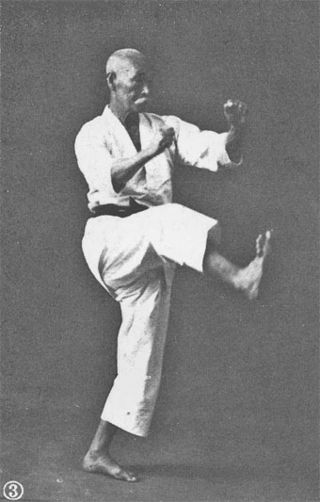
Karate (空手), also karate-do, is a martial art developed in the Ryukyu Kingdom. It developed from the indigenous Ryukyuan martial arts under the influence of Chinese martial arts. While modern karate is primarily a striking art that uses punches and kicks, traditional karate also employs throwing and joint locking techniques. A karate practitioner is called a karate-ka (空手家).

Shotokan is a style of karate, developed from various martial arts by Gichin Funakoshi (1868–1957) and his son Gigo (Yoshitaka) Funakoshi (1906–1945). Gichin Funakoshi was born in Okinawa and is widely credited with popularizing "karate do" through a series of public demonstrations, and by promoting the development of university karate clubs, including those at Keio, Waseda, Hitotsubashi (Shodai), Takushoku, Chuo, Gakushuin, and Hosei.
Shotokai is the organisation formed originally in 1930 by master Gichin Funakoshi to teach and spread the art of karate-Do. Nowadays, the name also designates a formal practice method.
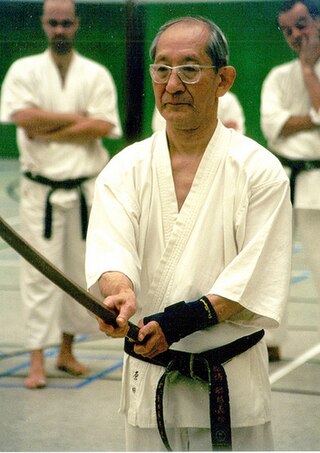
Mitsusuke Harada, MBE was a prominent Japanese master of Shotokai karate who introduced this martial art to Brazil and was after based in the United Kingdom. He founded the Karate-do Shotokai (KDS) organisation in 1965 and was its president. Harada held the rank of 5th dan, personally awarded by Gichin Funakoshi in 1956.
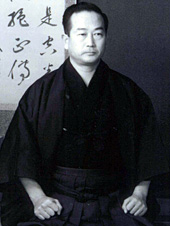
Masatoshi Nakayama[a] was an internationally famous Japanese master of Shotokan karate. He helped establish the Japan Karate Association (JKA) in 1949, and wrote many textbooks on karate, which served to popularize his martial art. For almost 40 years, until his death in 1987, Nakayama worked to spread Shotokan karate around the world. He was the first master in Shotokan history to attain the rank of 9th dan while alive, and was posthumously awarded the rank of 10th dan.
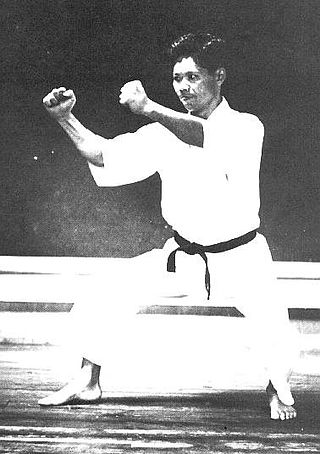
Gigō Funakoshi was the third son of Gichin Funakoshi and is widely credited with developing the foundation of the modern karate Shotokan style.
Hirokazu Kanazawa was a Japanese master of Shotokan karate. He was the Chief instructor and President of the Shotokan Karate-Do International Federation, an organisation he founded after he left the Japan Karate Association (JKA). Kanazawa was ranked 10th dan in Shotokan Karate.
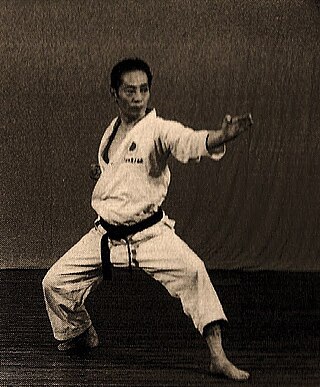
Tetsuhiko Asai was a prominent Japanese master of Shotokan karate of the Japan Karate Association (JKA), founder and Chief Instructor of the International Japan Martial Arts Karate Asai-ryu (IJKA), and founder of the Japan Karate Shoto Federation.

Gichin Funakoshi was the founder of Shotokan karate. He is known as a "father of modern karate". Following the teachings of Anko Itosu and Anko Asato, he was one of the Okinawan karate masters who introduced karate to the Japanese mainland in 1922, following its earlier introduction by his teacher Itosu. He taught karate at various Japanese universities and became honorary head of the Japan Karate Association upon its establishment in 1949. In addition to being a karate master, Funakoshi was an avid poet and philosopher. His son, Gigō Funakoshi, is widely credited with developing the foundation of the modern karate Shotokan style.

Teruyuki Okazaki, was a tenth degree black belt in Shotokan Karate, as well as the founder and chief instructor of the International Shotokan Karate Federation (ISKF). Along with Gichin Funakoshi and Masatoshi Nakayama, Okazaki helped found the Japan Karate Association's instructor training program.
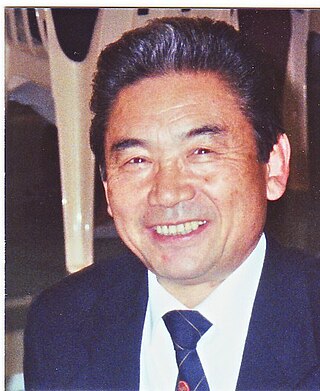
Takayuki Mikami is a Japanese master of Shotokan karate based in the United States of America. He holds the rank of 9th dan black belt in the art, awarded under the Japan Karate Association. In 1958, Mikami tied for first place in the All Japan Karate Championships. The following year, he became the All Japan champion in kumite (sparring) as well as kata (patterns). In 1961, Mikami won first place in kata again. He was also the first person to graduate from the Japan Karate Association's (JKA) instructor training program instituted by Gichin Funakoshi and Masatoshi Nakayama.

Keinosuke Enoeda was a Japanese master of Shotokan karate. He was a former Chief Instructor of the Karate Union of Great Britain. Enoeda was ranked 8th dan in Shotokan karate, and was widely renowned as a formidable karateka. Following his death, Enoeda was posthumously awarded the rank of 9th dan.
Toyotaro Miyazaki was a Japanese martial artist.
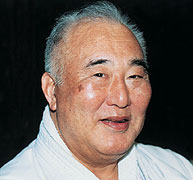
Taiji Kase was a Japanese master of Shotokan karate who was one of the earliest masters responsible for introducing this martial art into Europe. He taught his style of karate, Shotokan Ryu Kase Ha, in France from the late 1960s to the mid-1980s. In his later years, he travelled across the world teaching karate, but Paris remained his home. Kase held the rank of 9th dan in karate.
Isao Obata was a pioneering Japanese master of Shotokan karate. He was a senior student of Gichin Funakoshi, who is widely recognized as the founder of modern karate, and was a key figure in the establishment of the Japan Karate Association (JKA) under Funakoshi in 1949. Obata also helped introduce karate to the United States of America through his demonstrations of the art to United States Air Force personnel, and through his students, most notably Tsutomu Ohshima.
Japan Shotokan Karate Association (JSKA) was founded by Keigo Abe in 1999. Abe was a former instructor graduate of the Japan Karate Association and trained and taught at the JKA Headquarters for nearly 35 years. He held a number of senior positions within the JKA and latterly the Matsuno section of the JKA. He had been a senior student of Nakayama and as such the teachings of Nakayama remain an integral part of the evolution of the Shotokan style within the JSKA. Abe Sensei died on December 20, 2019. And he was awarded a posthumous 10th Dan by the JSKA Shihankai on his passing. The current Chief Instructor is Mitsuru Nagaki, 9th Dan, a student of Abe and former instructor with the Japan Karate Shotorenmei.
Kunio Kobayashi is a Japanese instructor of Shotokan karate. He has won the JKA All-Japan championships for kata on 2 occasions and for kumite on 3 occasions. He is currently an instructor of the Japan Karate Association.
Keisuke Nemoto is a Japanese instructor of Shotokan karate. He has won the JKA All-Japan championships for kumite. He is currently an instructor of the Japan Karate Association.
Kazuaki Kurihara is a Japanese instructor of Shotokan karate. He has won the JKA's version of the world championships for kata on 2 occasions. He has also won the JKA All-Japan championships for kata on 7 occasions and once for kumite. He is currently an instructor of the Japan Karate Association.













